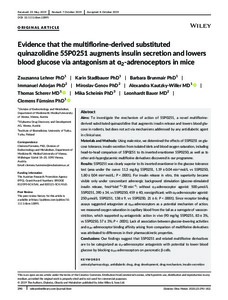Evidence that the multiflorine‐derived substituted quinazolidine 55P0251 augments insulin secretion and lowers blood glucose via antagonism at α2‐adrenoceptors in mice
Lehner Z; Stadlbauer K; Brunmair B; Adorjan I; Genov M; Kautzky-Willer A; Scherer T; Scheinin M; Bauer L; Fürnsinn C
https://urn.fi/URN:NBN:fi-fe2021042825974
Tiivistelmä
To investigate the mechanism of action of 55P0251, a novel multiflorine‐derived substituted quinazolidine that augments insulin release and lowers blood glucose in rodents, but does not act via mechanisms addressed by any antidiabetic agent in clinical use.
Materials and Methods
Using male mice, we determined the effects of 55P0251 on glucose tolerance, insulin secretion from isolated islets and blood oxygen saturation, including head‐to‐head comparison of 55P0251 to its inverted enantiomer 55P0250, as well as to other anti‐hyperglycaemic multiflorine derivatives discovered in our programme.
Results
55P0251 was clearly superior to its inverted enantiomer in the glucose tolerance test (area under the curve: 11.3 mg/kg 55P0251, 1.19 ± 0.04 min*mol/L vs 55P0250, 1.80 ± 0.04 min*mol/L; P < .0001). For insulin release in vitro, this superiority became visible only under concomitant adrenergic background stimulation (glucose‐stimulated insulin release, fmol*islet−1*30 min−1: without α2‐adrenoceptor agonist: 500 μmol/L 55P0251, 390 ± 34, vs 55P0250, 459 ± 40, nonsignificant; with α2‐adrenoceptor agonist: 250 μmol/L 55P0251, 138 ± 9, vs 55P0250, 21 ± 6; P < .0001). Since receptor binding assays suggested antagonism at α2A‐adrenoceptors as a potential mechanism of action, we measured oxygen saturation in capillary blood from the tail as a surrogate of vasoconstriction, which supported α2‐antagonistic action in vivo (90 mg/kg 55P0251, 83 ± 3%, vs 55P0250, 57 ± 3%; P < .0001). Lack of association between glucose‐lowering activities and α2A‐adrenoceptor binding affinity arising from comparison of multiflorine derivatives was attributed to differences in their pharmacokinetic properties.
Conclusions
Our findings suggest that 55P0251 and related multiflorine derivatives are to be categorized as α2‐adrenoceptor antagonists with potential to lower blood glucose by blocking α2A‐adrenoceptors on pancreatic β cells.
Kokoelmat
- Rinnakkaistallenteet [27094]
